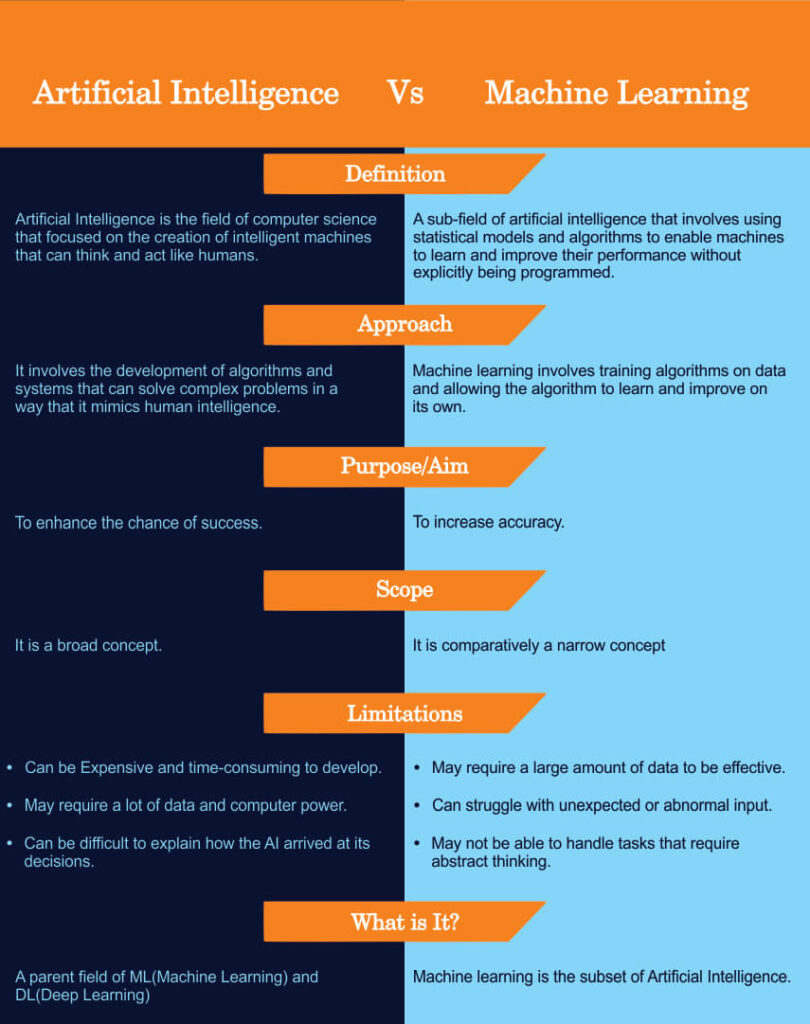Have you ever wondered what the difference between Artificial Intelligence and Machine Learning is? With the rise of technology, it can be hard to keep track of all the new terms being thrown around. So, in this article, we will delve into the complete distinction between AI and ML to gain a better understanding of what each is capable of and how they work. Additionally, I will discuss the advantages and disadvantages of using each technology in various fields.
You Can Also Read: Difference Between Data Science and Artificial Intelligence
What is Artificial Intelligence(AI)?
AI (Artificial Intelligence) is the simulation of human intelligence in machines that are programmed to think and act like humans. This can be done in a number of ways, including but not limited to: rule-based systems, decision trees, artificial neural networks, genetic algorithms, and fuzzy logic systems. It is used to create intelligent systems that have the capacity to learn and adapt to changing environments.
These intelligent machines can be trained to perform a wide range of tasks, such as recognizing patterns, making decisions, and solving problems. There are several different types of AI, including Narrow AI, which is designed to perform a specific task. Another one is General AI, which is designed to be able to perform any intellectual task that a human can.
Moreover, AI has been used in a variety of fields, such as natural language processing, robotics, computer vision, and gaming. AI is also being used in more complex applications such as financial planning, medical diagnosis, and autonomous navigation. AI may be used to solve problems that are too difficult or time-consuming for humans to solve on their own.
Examples of Artificial Intelligence
Some examples of artificial intelligence nowadays are:
1. Virtual Assistants like Siri and Alexa:
- Use natural language processing to understand spoken commands and respond
- Utilize deep learning to interpret user requests and reply with the most appropriate answer
- Can be used to perform a variety of tasks such as setting reminders, playing music, making phone calls, etc.
2. Computer Vision:
- Uses algorithms and machine learning techniques to interpret digital images and videos
- Can be used for facial recognition, object detection/classification, autonomous vehicles, etc.
- Employs convolutional neural networks (CNNs) for feature extraction from images/videos.
3. Robotics:
- Combines hardware engineering with AI software algorithms to create robots that can interact with their environment
- Includes motion planning and path-finding algorithms for autonomous navigation in unknown environments
- Makes use of computer vision for obstacle avoidance and object manipulation
4. Autonomous cars:
- Use a combination of AI technologies including computer vision and natural language processing
- Utilize deep learning algorithms to interpret data from sensors and cameras in order to make decisions
- Aim to provide a safer, more efficient alternative to human-driven cars.
Three Advantages of Artificial Intelligence(AI)
- Increased efficiency: AI can perform tasks faster and more accurately than humans, which can lead to increased efficiency and productivity.
- Improved decision-making: AI can analyze large amounts of data and make data-driven decisions, which can be more objective and accurate than decisions made by humans.
- Automation of tedious tasks: AI can automate repetitive and tedious tasks, freeing up humans to focus on more creative and strategic work.
Three Disadvantages of Artificial Intelligence
- Job displacement: As AI becomes more advanced, it may replace human workers in certain industries, leading to job displacement and unemployment.
- Lack of empathy: AI systems do not have the ability to understand or experience emotions, which can make them inadequate for certain types of decision-making or customer service tasks that require empathy.
- Bias in data: If the data used to train an AI system is biased, the AI system may also be biased in its decision-making and actions. This can perpetuate and amplify existing societal biases.
What is Machine Learning(ML)?
Machine learning is a subset of artificial intelligence that deals with the ability of machines to learn from data and experience, without being explicitly programmed. This is done through a number of techniques, including but not limited to: linear regression, logistic regression, Support Vector Machines, decision trees, and artificial neural networks.
The goal of machine learning is to create models that can make predictions about new data. Moreover, machine learning can be used to improve the accuracy, speed, and scalability of all types of systems.
Some Examples of Machine Learning
Some of the common examples of machine learning are:
- Supervised learning: A model is trained on a labeled dataset, meaning that for each example the desired output is known.
- Unsupervised learning: A model is trained on an unlabeled dataset, meaning that for each example the desired output is not known.
- Reinforcement learning: A model is trained using a feedback mechanism, where the model gets positive or negative reinforcement based on its performance.
You May Also Want to Learn: Difference Between Data Science and Data Analytics
Artificial Intelligence Vs Machine Learning(Comparison Table)
The following table compares both AI vs ML in a brief way.

6 Key Differences Between Artificial Intelligence and Machine Learning
AI (Artificial Intelligence) and ML (Machine Learning) are two closely related concepts, but they are not the same thing. Here are three key differences between AI and ML:
- AI is a broader term that encompasses both machine learning and other approaches to making computers smarter. On contrary, Machine learning is a subset of Artificial intelligence that deals with the ability of machines to learn from data and enhance their performance over time.
- AI is a broad term that refers to the ability of a machine to exhibit intelligent behavior. ML, On the other hand, is a specific approach to achieving AI. ML involves training a machine using data and algorithms so that it can make decisions or predictions on its own.
- AI can encompass a wide range of capabilities, including perception, reasoning, learning, and decision-making. In contrast, Machine learning(ML) is focused on the ability to learn from data.
- Machine learning is mainly focused on pattern recognition. On the other hand, AI can encompass a wider range of tasks.
- AI models can be either supervised or unsupervised. In contrast, Machine learning models are mainly supervised.
- Machine learning focuses on computational efficiency, while AI also focuses on human-like qualities such as reasoning and problem-solving.
Applications of Artificial Intelligence(AI) and Machine Learning(ML)
There is a wide range of applications of AI and ML in different industries and fields. Here we have mentioned five of the most common.
- Healthcare: Artificial intelligence and machine learning can be used in healthcare for tasks such as image analysis, natural language processing, and predictive modeling. For example, AI can be used to analyze medical images to identify abnormalities. Natural language processing can be used to extract information from electronic medical records, and predictive models can be used to predict patient outcomes.
- Finance: AI and machine learning are widely used in the finance industry for tasks such as fraud detection, risk assessment, and portfolio management. For example, AI can be used to detect unusual patterns of activity that may indicate fraud. Machine learning algorithms can be used to assess risk in investment portfolios, and predictive models can be used to forecast market movements.
- Retail: AI and machine learning are increasingly being used in the retail industry for tasks such as demand forecasting, pricing optimization, and personalized recommendations. For example, machine learning algorithms can be used to forecast demand for products, optimize prices based on market conditions, and provide personalized recommendations to customers based on their past purchases.
- Manufacturing: AI and machine learning can be used in manufacturing to optimize production processes, improve quality control, and predict maintenance needs. For example, AI can be used to analyze data from sensors on production equipment to identify patterns that indicate when maintenance is needed, and machine learning algorithms can be used to optimize production schedules and improve quality control.
- Transportation: AI and machine learning are being used in the transportation industry for tasks such as autonomous vehicles, route optimization, and predictive maintenance. For example, machine learning algorithms can be used to improve the accuracy of autonomous vehicles. It also optimizes routes for delivery vehicles and predicts when maintenance is needed for transportation equipment.
Conclusion
To summarize, artificial intelligence and machine learning are both important components of modern computing. AI is the broader umbrella under which many technologies such as natural language processing, robotics, and computer vision fall. Machine learning is a subset of AI that harnesses data to create models that can predict future outcomes or detect patterns in complex datasets. While they have many similarities, there are also distinct differences between the two disciplines that make each one unique in its own right.
References:




One Comment